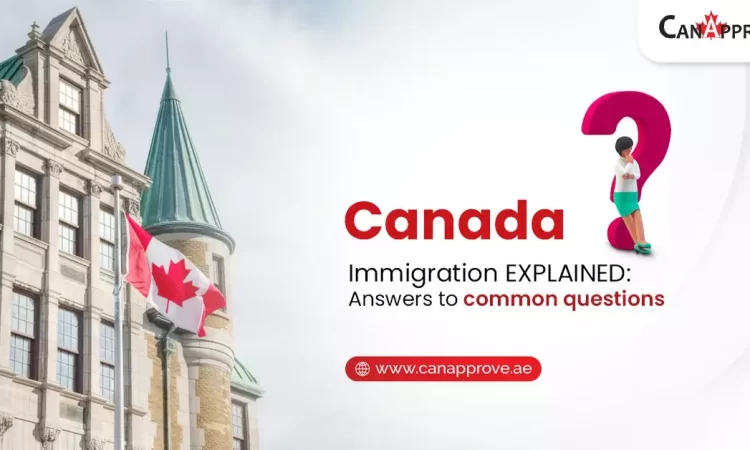Tracing back to the modern Canadian immigration system that possibly began in 1967, the “immigration points system” has evolved considerably today. While a lot of information is already available, we thought it would be best to come up with a Q&A-styled blog about Canada immigration for dummies to help you understand your chances of qualifying.
Understanding Canada Immigration 101
Canada immigration 101 lessons will give you a basic understanding of the scope of immigration in Canada. In Canada, immigration is the act granting permanent residency status, including to refugees. Furthermore, all Canada permanent residency holders are eligible to apply for Canadian citizenship after meeting certain requirements.
Let’s begin Part-3 of Canada immigration 101 lessons by answering the top 4 frequently asked questions about the immigration journey to Canada. Click on the links to read Part-1 & Part-2 of our Canada Immigration for Dummies blog series.
Q. What are IRCC’s visa processing times right now?
Immigration, Refugees, and Citizenship Canada (IRCC) are standing on a backlog of about 1.84 million applications waiting to be processed. However, IRCC has made good progress in economic-class programs like Express Entry CEC and FSWP applicants but continues to struggle in other areas, such as processing citizenship applications.
As of March 31, 2022, the application processing times are:
Economic class immigration
- Express Entry Canadian Experience Class (CEC): 7 months
- Express Entry Federal Skilled Worker Program (FSWP): 27 months
- Express Entry Federal Skilled Trades Program (FSTP): 27 months
- Express Entry Provincial Nominee Program (PNP): 22 months
- Non-Express Entry aligned PNP: 27 months
- Quebec skilled worker streams: 31 months
- Atlantic Immigration Program: 14 months
Study Visa in Canada
- Study permit outside Canada: 13 weeks
- Study permit inside Canada: 9 weeks
- Study permit extension: 75 days online and 156 days by paper
Temporary residence application
- Visitor visa outside Canada: Varies by country
- Visitor visa inside Canada: 16 days online and 48 days by paper
- Parents or grandparents Super Visa: Varies by country
- Work permit outside Canada: Varies by country
- Work permit inside Canada (initial application or extension): 133 days online and 239 days by paper
Family class immigration
- Spouse or common-law partner living in Canada: 12 months
- Spouse or common-law partner living outside Canada: 19 months
- Parents or grandparents: 32 months
- Protected persons and convention refugees in Canada: 22 months
Tracking the processing times at IRCC may help you plan for your Canada immigration. If you require further assistance in choosing the right kind of immigration program that compliments your work or academic profile, feel free to get in touch with CanApprove.
Q. Are there any COVID-19 related travel restrictions in Canada?
Unlike immigration-friendly Australia, Canada maintained a fairly open immigration policy even during the initial peaks of the pandemic in 2020-21.
The latest update as of April 1, 2022, is that fully vaccinated travellers will no longer need a pre-arrival COVID-19 test to enter Canada. However, Travellers will still need to submit proof of vaccination status along with other mandatory information through the ArriveCAN app.
COVID-19 vaccines from eight different manufacturers are approved and accepted by Canada including:
- Pfizer;
- Moderna;
- Astra-Zeneca;
- Johnson&Johnson;
- Bharat Biotech;
- Novavax;
- Sinopharm BIBP; and
- Sinovac.
While a booster shot is not required, the last dose must be taken at least 14 days before your arrival in Canada.
Q. Is it the right time to enter the Express Entry pool for PR nomination?
Provincial Nominee Program held record-high nomination draws in the first three months of 2022. Despite this, IRCC could manage only 6,470 Express Entry candidates to apply for Canada permanent residency during this period.
As a direct consequence of application backlogs in Express Entry applications for permanent residence, IRCC halted draws for Canadian Experience Class (CEC) candidates in September 2021 and has not held a single draw for Federal Skilled Worker Program (FSWP) candidates since December 2020.
The case of Express Entry draws used to be different before the pandemic. Most Express Entry draws were not program-specific and candidates could receive an invitation to apply (ITA) for Canada PR as long as their Comprehensive Ranking System (CRS) score was high. The CRS score is majorly dependent on age, education, work experience, and language proficiency among other criteria.
As Canada is increasing immigration opportunities, Minister Sean Fraser has suggested resuming Express Entry draws for skilled workers as early as in the spring.
So, YES. Now is the right time to enter the Express Entry pool to qualify for Canada permanent residency. The profile is valid for 12 months after which you can renew it based on your upgraded skills.
Q. How can I Immigrate to Canada along with my spouse and dependent children?
The most common and easiest way is to enter the Express Entry pool together or apply for a suitable Provincial Nominee Program. Click here to understand the process better.
The other way is to immigrate to Canada through Family Sponsorship programs. About 80,000 immigrants to Canada each year are welcomed under the Spouses, Partners, and Children Sponsorship Program, simply known as Spousal Sponsorship. Click here to read more about it.
This concludes Part-3 of our Canada immigration 101 series. Don’t forget to book your free appointment with CanApprove to determine your eligibility based on your work or academic profile.



